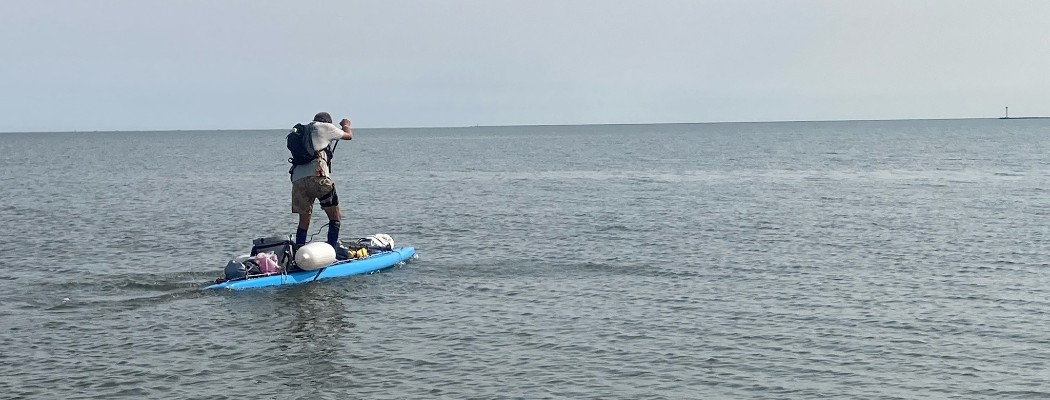Ultra-endurance athlete Adam Nagler’s standup paddle from Virginia to Nantucket.
On January 15, 2014, Adam Nagler looked himself in the mirror and said, “I am going to die, if I keep this up.” He was forty-six years old, overweight and disgruntled from decades of working desk jobs. Five years earlier, Nagler underwent open heart surgery after a freak infection nearly destroyed two of his heart valves. Still sickly, Nagler believed that if he didn’t change his life, he would only have a couple years left. While most people might have just joined a gym or gone on vacation to quell their midlife crisis, Nagler went to truly extreme lengths to reroute his life.
 Today, this fifty-four-year-old is an entirely different breed of human being, pushing himself through audacious feats of endurance so grueling that they border on madness. His most recent adventure—attempting to stand-up paddle more than 450 miles nonstop from Chesapeake Bay to Nantucket to raise money for Fairwinds–Nantucket’s Counseling Center—was by far his most daring. At press time, Nagler was more than two weeks into this wild adventure that left some wondering whether his effort to change his life might just cost him that life.
Today, this fifty-four-year-old is an entirely different breed of human being, pushing himself through audacious feats of endurance so grueling that they border on madness. His most recent adventure—attempting to stand-up paddle more than 450 miles nonstop from Chesapeake Bay to Nantucket to raise money for Fairwinds–Nantucket’s Counseling Center—was by far his most daring. At press time, Nagler was more than two weeks into this wild adventure that left some wondering whether his effort to change his life might just cost him that life.
“My mission is to crush the younger versions of myself,” Nagler explained of the series of endurance expeditions he began seven years ago. “I want to leave it all on the field of middle age en route to becoming a world-class fifty-plus-year-old ‘hard and fast’ ultra-endurance athlete.” In that pursuit, Nagler has pedaled more than three thousand miles on a mountain bike, logging enough vertical feet along the way to reach the summit of Everest more than twice. He has covered more than a thousand miles over a ten-day span, running, mountain biking, paddling and in-line skating—losing fourteen pounds and three toenails in the process. Six weeks after that effort, as part of what he called “The Strong Island Special,” Nagler standup paddled from the Brooklyn Bridge to Nantucket, some 246 miles in 151 hours. A day later, he got back on his board and paddled back to Quogue, New York—another 175 miles. Mind you, all this paddling came after he ran 127 miles and cycled a total of 391 miles.
In these endurance expeditions, Nagler has no sponsors. He’s not competing against anyone. There are no camera crews or spectators watching. Instead, these extraordinary physical tests are part of a long-term personal campaign he has dubbed “This Is Fifty Suffer Fest Tour.” “It’s a multiyear series of solo, self- supported, brutally hard, exceptional in their obscurity, cost-efficient, nonprofit fundraiser epics,” Nagler explained.
Benefiting organizations ranging from the National Outdoor Leadership School to Search and Rescue in Santa Barbara, California, where Nagler lives, each fundraising expedition follows a fifteen-point criteria that he drew up, detailing everything from the kind of gear he uses (only off-the-shelf factory equipment) to the safety measures he takes (“always have backups for your backups”). Then there’s the training. Over the last seven years, Nagler has logged more than 55,000 miles of cycling, running, skating and paddling. He’s trained with ex-military brass and endured enough hours of suffering—more than 10,000—to achieve master status.
 Titled “Deep Fog Direct,” Nagler’s paddle expedition from the Charles Lighthouse on the northern side of Chesapeake Bay to Nantucket’s Brant Point would call upon every shred of his training. Seeking to set the record for the longest distance paddled on a factory board, Nagler turned a fourteen-foot board that he bought second-hand for $900 into a life-support system where he planned to remain for the next two weeks or more. Equipped with a compass, elaborate storage compartments and a jerry-rigged steering system, the board would also tow a 225-pound water caddy, which was Nagler’s only source of sustenance. He wouldn’t pack a bite of food, but planned on surviving entirely on a nutrient-dense powder that he mixed with the water. “In my mind, I pretend that I’m having a great cup of coffee with bacon,” Nagler described before his departure, “but it’s not fun.”
Titled “Deep Fog Direct,” Nagler’s paddle expedition from the Charles Lighthouse on the northern side of Chesapeake Bay to Nantucket’s Brant Point would call upon every shred of his training. Seeking to set the record for the longest distance paddled on a factory board, Nagler turned a fourteen-foot board that he bought second-hand for $900 into a life-support system where he planned to remain for the next two weeks or more. Equipped with a compass, elaborate storage compartments and a jerry-rigged steering system, the board would also tow a 225-pound water caddy, which was Nagler’s only source of sustenance. He wouldn’t pack a bite of food, but planned on surviving entirely on a nutrient-dense powder that he mixed with the water. “In my mind, I pretend that I’m having a great cup of coffee with bacon,” Nagler described before his departure, “but it’s not fun.”
Though based in Santa Barbara, Nagler has been connected to Nantucket since 1989 when he first came to the island to stay with his college friend John Arena. He’s returned most every summer since, maintaining friendships with year-round island residents. During the depths of the COVID-19 pandemic last year, Nagler learned of the heavy mental health burdens plaguing many year-round Nantucketers. “That’s when I really dug into who was helping islanders during that most difficult time and discovered Fairwinds,” Nagler explained of the beneficiary of his paddle to Nantucket. “I hope to raise $35,000 for the organization.”
Unlike with other long-distance, open-ocean paddling attempts, Nagler’s makeshift board wasn’t equipped with any kind of sleeping quarters. Instead, when it came time to rest, he planned on donning a thick wet suit, wrapping himself up in a silver bivvy bag, setting out a sea anchor, and then strapping himself to the board for the night. His whole strategy was to paddle himself to such extreme exhaustion each day that by the time he lay down on the board, he’d have no other option but to just pass out. Of course, the idea of achieving any kind of meaningful rest while bobbing like a piece of jetsam in a rolling ocean in the middle of the night is almost impossible to fathom. Indeed, the many perils surrounding Nagler’s expedition were mind-numbing.
 Planning to skirt just off the Gulf Stream in taking a direct route to Nantucket from Virginia, Nagler knew that he was incredibly vulnerable to fast-forming tropical storms. “They can blow up quickly,” he described before his departure. “They can go from a zero percent probability to being a tropical system six hours later.” Storms could bring lightening, perhaps the second gravest danger to Nagler, who would represent the tallest object on the open ocean. Out of sight of land, he would need to pass through shipping lanes, which are especially treacherous when thick fog rolled in. Apart from a handheld radar that he could only use sparingly to conserve battery power, Nagler would rely on his ears to identify any freighters cruising at him through the mist. Finally, in what might be the most obvious threat in many people’s minds, Nagler would be crossing through waters known for great white sharks.
Planning to skirt just off the Gulf Stream in taking a direct route to Nantucket from Virginia, Nagler knew that he was incredibly vulnerable to fast-forming tropical storms. “They can blow up quickly,” he described before his departure. “They can go from a zero percent probability to being a tropical system six hours later.” Storms could bring lightening, perhaps the second gravest danger to Nagler, who would represent the tallest object on the open ocean. Out of sight of land, he would need to pass through shipping lanes, which are especially treacherous when thick fog rolled in. Apart from a handheld radar that he could only use sparingly to conserve battery power, Nagler would rely on his ears to identify any freighters cruising at him through the mist. Finally, in what might be the most obvious threat in many people’s minds, Nagler would be crossing through waters known for great white sharks.
After having his departure delayed by weather, Nagler launched from Fishermans Inlet in Virginia on July 3rd. He paddled thirty hours through the night, taking intermittent catnaps while sitting on his board. “I’d doze off and then jerk awake and keep paddling,” he said. “So I didn’t get a good night’s sleep, by any means, but I did get a bit of shut eye.” Nagler’s original course was to paddle from Fishermans Inlet to Brant Point as the crow flies, a direct line northeast that would lead him way offshore. Yet after the first day, Nagler realized that he needed to stay closer to shore. Because if a storm rose up, he wouldn’t be able to paddle to safety in time, given the fact that he was hauling 250 pounds of supplies.
By the second night, Nagler desperately needed sleep. He paddled himself a quarter mile outside a series of shoals where waves were breaking and prepared to spend the night on his board. Working by headlamp, he set out a sea anchor, blew up his sleeping mat, slipped into his bivvy bag and lay down on the board to try to get some rest. It was short-lived. About forty-five minutes later, a rogue wave rolled through and crashed on top of him. Nagler was thrown from his board, which was then pinned upside down by all the weight of his gear.
 Swimming back to his board by headlamp, Nagler was eventually able to flip his board right side up, revealing a stew of lines, including the one still attached to the sea anchor. “Because the tide had gone out, the sets started coming in,” Nagler recalled. “I could hear them breaking to my left and to my right. I only had a couple of minutes before another wave was going to plow me.” Needing to get out of the breaker zone as quickly as possible, Nagler undid the sea anchor and let the ocean take it. He then paddled outside the breakers and reassessed the situation. “Here I am, it’s four-to six-foot seas, it’s pitch black, there’s no moon out there,” Nagler recalled. “I was too tired, the swells were everywhere, and I just said, ‘I need to live another day and in order to do that, I need to get to the beach.’”
Swimming back to his board by headlamp, Nagler was eventually able to flip his board right side up, revealing a stew of lines, including the one still attached to the sea anchor. “Because the tide had gone out, the sets started coming in,” Nagler recalled. “I could hear them breaking to my left and to my right. I only had a couple of minutes before another wave was going to plow me.” Needing to get out of the breaker zone as quickly as possible, Nagler undid the sea anchor and let the ocean take it. He then paddled outside the breakers and reassessed the situation. “Here I am, it’s four-to six-foot seas, it’s pitch black, there’s no moon out there,” Nagler recalled. “I was too tired, the swells were everywhere, and I just said, ‘I need to live another day and in order to do that, I need to get to the beach.’”
At 2 a.m., Nagler navigated through the breakers to reach a safe spit of sand, one of the Virginia Barrier Islands, which he believed was probably Hog Island. Leaning up his board in the sand to create a wind barrier, he slid into his emergency sleeping bag and finally fell asleep. The next morning, Nagler organized his gear, shook off the memories of the night before, and launched back into the Atlantic. “You have to compartmentalize those things,” he said. “Like they say about quarterbacks: If you throw an interception, you have to forget it pretty quickly and go on to the next play.”
In the ensuing weeks, Nagler had to compartmentalize a lot. Two days after being capsized, tropical storm Elsa forced him back to shore where a friend of a friend was able to meet him at the Maryland border and give him a place to stay. The storm gave him a couple of days to lick his wounds and reassess his strategy. His feet were so badly damaged by cellulitis that he needed to be pumped full of antibiotics. “The strategy of the water caddy and staying out at sea was precarious at best,” he said. “I just couldn’t move fast enough out of the way of trouble.” Jettisoning the water caddy, Nagler relaunched after the storm passed and stayed closer to the shoreline, where he would spend nights sleeping on the beach and replenish his water and supplies.
At press time, Nagler had reached Spring Lake, New Jersey, and was preparing to make a forty-five-mile crossing to Fire Island, New York, on his way to Nantucket. He had lost fourteen pounds, had dozens of shark sightings and even been hauled out of the water for questioning by law enforcement officials in New Jersey. Renaming the expedition “Deep Fog Re-Direct,” Nagler had to reimagine his strategy and his route as more obstacles were thrown in his way. “Each time you square away your gear, you repair anything that needs to be repaired, you heal your body where you can, and you go through why you made a mistake and how you could have prevented that situation,” he explained. “I then look at the terrain in front of me and try to apply the knowledge gained so the mistake doesn’t happen again. Something else will happen, but not that exact mistake.” And then when in doubt, Adam Nagler repeated his mantra: Keep paddling. Keep paddling. Just keep paddling.
Read the conclusion to Adam Nagler’s adventure here.









